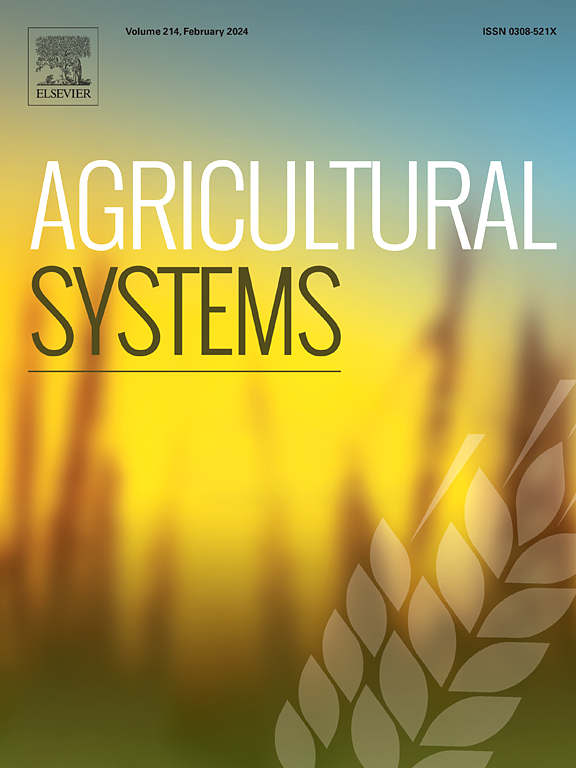On-farm water quality: Co-design of result-based indicators
IF 6.1
1区 农林科学
Q1 AGRICULTURE, MULTIDISCIPLINARY
引用次数: 0
Abstract
CONTEXT
Pollution of water resources by substances emitted by agriculture, such as nitrate, pesticides, pharmaceutical residues, fecal microorganisms and microplastics, remains a crucial issue. To assess the effectiveness of pollution-mitigation projects, water quality is usually monitored at the watershed scale. In parallel, farmers and agricultural advisors use mainly means-based indicators to assess farm sustainability. In Brittany, France, the Terres de Sources project addresses the following issues: (i) individual farmers cannot assess effects of changes in their practices using result-based water-quality indicators at the watershed outlet and (ii) means-based indicators provide little information about local water quality.
OBJECTIVE
The aim of this project was to gather together researchers, farmers and advisors to build operational result-based indicators that would allow farmers to estimate on-farm emissions of pollutants to water. This article highlights the implementation and outputs of a collective design process to create such indicators.
METHODS
The Knowledge-Concepts-Proposals design method was implemented to explore ideas around the initial concept of “result-based water-quality indicators at the farm scale”. The method's design process has four steps, from initiation to outputs. Emerging ideas of indicators were classified in four categories and we finally selected scientifically relevant and achievable indicators. The methods for measuring these indicators were worked during the final phase of the design process.
RESULTS AND CONCLUSIONS
The main results of the design process were (i) a set of result-based indicators focused on nitrate and pesticides and related to chemical measurements and bioindicators, (ii) the development of phases of “farm characterization” and “on-farm monitoring strategy” to understand water circulation, the relevant “types of water” to sample and suitable on-farm monitoring locations. In addition, breakthrough ideas have emerged but not exploited in this project; they were related to indicators based on senses and on exposure of livestock to pollutants. Despite fixation effects, the group was actively involved in the design process and in the proposal of subsequent prototype testing on farms.
SIGNIFICANCE
Most of the indicators selected had already been developed at the watershed scale, but attempting to adapt them to the farm scale was an originality. Farm-scale studies help understand sources of pollutant emissions that decrease water quality. Farmers' use of comprehensive assessment tools would help encourage them to pursue their efforts in agroecological transition.

农场水质:基于结果指标的共同设计
农业排放的物质,如硝酸盐、农药、药物残留、粪便微生物和微塑料对水资源的污染仍然是一个关键问题。为了评估污染缓解项目的有效性,通常在流域尺度上监测水质。与此同时,农民和农业顾问主要使用基于手段的指标来评估农场的可持续性。在法国布列塔尼,土地资源项目解决了以下问题:(i)个别农民无法在流域出口使用基于结果的水质指标来评估其做法变化的影响;(ii)基于手段的指标提供的关于当地水质的信息很少。该项目的目的是将研究人员、农民和顾问聚集在一起,建立基于结果的操作指标,使农民能够估计农场向水中排放的污染物。本文重点介绍了创建此类指标的集体设计过程的实现和输出。方法采用“知识-概念-建议”设计方法,围绕“基于结果的农场尺度水质指标”的初步概念进行探索。该方法的设计过程有四个步骤,从启动到输出。将新兴的指标思路分为四类,最终选择出科学相关、可实现的指标。测量这些指标的方法是在设计过程的最后阶段进行的。结果与结论设计过程的主要成果是:(1)制定了一套以硝酸盐和农药为重点、与化学测量和生物指标相关的基于结果的指标;(2)制定了“农场表征”和“农场监测策略”阶段,以了解水循环、与样本相关的“水类型”和合适的农场监测地点。此外,突破性的想法已经出现,但没有在这个项目中得到利用;它们与基于感官和牲畜暴露于污染物的指标有关。尽管存在固定效应,但该小组积极参与了设计过程,并提出了随后在农场进行原型测试的建议。所选择的大多数指标已经在流域尺度上制定,但试图使它们适应农场规模是一种独创性。农场规模的研究有助于了解降低水质的污染物排放的来源。农民使用综合评估工具将有助于鼓励他们在农业生态转型中继续努力。
本文章由计算机程序翻译,如有差异,请以英文原文为准。
求助全文
约1分钟内获得全文
求助全文
来源期刊

Agricultural Systems
农林科学-农业综合
CiteScore
13.30
自引率
7.60%
发文量
174
审稿时长
30 days
期刊介绍:
Agricultural Systems is an international journal that deals with interactions - among the components of agricultural systems, among hierarchical levels of agricultural systems, between agricultural and other land use systems, and between agricultural systems and their natural, social and economic environments.
The scope includes the development and application of systems analysis methodologies in the following areas:
Systems approaches in the sustainable intensification of agriculture; pathways for sustainable intensification; crop-livestock integration; farm-level resource allocation; quantification of benefits and trade-offs at farm to landscape levels; integrative, participatory and dynamic modelling approaches for qualitative and quantitative assessments of agricultural systems and decision making;
The interactions between agricultural and non-agricultural landscapes; the multiple services of agricultural systems; food security and the environment;
Global change and adaptation science; transformational adaptations as driven by changes in climate, policy, values and attitudes influencing the design of farming systems;
Development and application of farming systems design tools and methods for impact, scenario and case study analysis; managing the complexities of dynamic agricultural systems; innovation systems and multi stakeholder arrangements that support or promote change and (or) inform policy decisions.
 求助内容:
求助内容: 应助结果提醒方式:
应助结果提醒方式:


